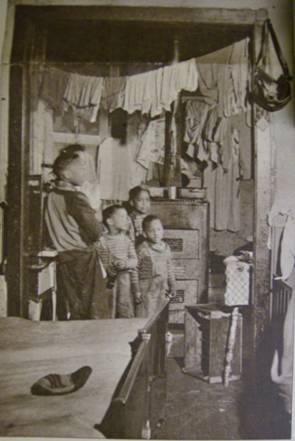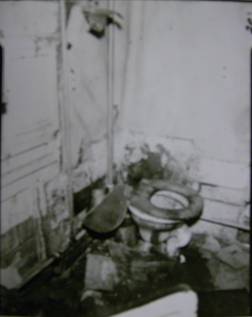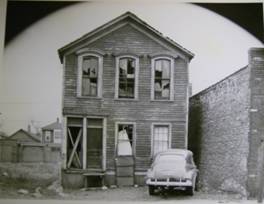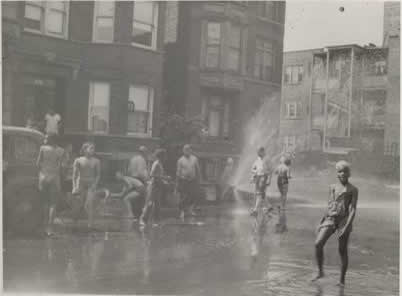
In an effort to tell the story of ordinary people, historians often examine history from the bottom up. Good social history places human experiences in the context of the political climate of the time. The history of the CHA during the Great Depression and World War II contains numerous opportunities for historians to write about various social concerns. Just as Americans struggled with new roles for the federal government in regulating and guaranteeing access to elevated minimum standards of living, so too did they struggle with the question of who would reap the benefits of expanded governmental services.
Given the acute housing shortage in Chicago and long tenant waiting lists for the yet-to-be-build public housing buildings, the CHA faced the difficult task of determining standards that qualified the ill-housed for residence in the projects. Historians have pointed to “tenant selection” as contributing to public housing’s problems in the second half of the twentieth century. Factors considered by the CHA and other housing authorities in determining the worthiness of tenants included employment status, income, race, condition of previous housing, age and family make-up.
Considering Tenant Selection
In their efforts to clear slums, house the impoverished, and placate real estate interests, the CHA established a rigid set of requirements for tenants, which significantly limited the diversity of residents. Program officials selected tenants on the basis of numerous criteria, including: income, marital and parental status, age, condition of previous housing, citizenship, and, during the war, employment in war production.
Prior to the war, the average tenant was: employed, making no more than five times his rent; Caucasian; recently living in a blighted area; and married with children. Wartime production booms brought nearly full employment to Chicago, and provided white Chicagoans with marked improvement in their economic situation, leaving many previous occupants ineligible for CHA housing.
The description of the average CHA tenant in the years surrounding World War II is in direct contradiction to what historians know about occupants at the turn of the twenty-first century. In the 1990s, tenants of public housing in Chicago were largely non-white, lacking full time employment, and unmarried. To write good historical research, you must remember to think in context of the time you are researching. In the 1930s and 1940s, there were long waiting lists of tenants who wanted to live in CHA housing, many of whom encountered discrimination from the CHA, just as they did from private sector landlords
Housing for African-Americans prior to federally-funded projects in the 1930s was scarce, largely segregated to the “Black Belt,” and was often of the poorest quality. In 1910 there were fewer than 50,000 African-Americans living in Chicago. During the Great Migration, thousands of African-Americans moved from the South to northern industrial cities in the 1910s and 1920s. Chicago’s Black population increased that number fivefold so that by 1930 there were 233,903 African-Americans living in Chicago.1
Most of the African-American community lived in the “Black Belt,” a neighborhood along State Street, stretching from 18th to 39th Street. Despite rampant overcrowding, African-Americans found few housing alternatives as South Side residents developed restrictive covenants to maintain white domination to the east, south, and west of the Black Belt. Expansion to the north into the Chicago Loop was cost prohibitive.
Although there were enclaves of African-Americans living in other parts of the city, the majority of those who needed CHA housing were packed into the Black Belt. As the CHA opened its new buildings for occupancy, African-Americans did get access to some of the units, particularly the all-black Ida B. Wells homes.
During World War II, many white European Americans advanced in the booming economy to the point that they earned more than the maximum one could to qualify for public housing. As the majority of those who no longer qualified to live in CHA buildings were white, African-Americans moved up the long waiting lists more quickly, but met resistance in several of the neighborhoods where the new public housing was built.
The Francis Cabrini Homes present an excellent example of racial exclusion. In leveling the slum known as “Little Hell” on Chicago’s Near North Side, CHA officials agreed to maintain in the Cabrini Homes the racial consistency of a neighborhood that had been 80% white and 20% black. By 1944, white would-be-residents had capitalized on the economic opportunities of the war to the extent that there were no longer enough qualifying families on the waiting list to occupy the allotted 469 of the 586 total units. African-American were vocally resistant to the seemingly arbitrary enforcement of the race-based quota, and eventually got their allotment expanded to 40%.2
When considering CHA standards for occupancy of housing projects, historians ask these kinds of questions:
- We know that housing reformers, planners, and real estate interests steered public housing administrators in tenant selection. How did each group influence the profile of tenants?
- Were the standards in tenant selection consistent with larger public housing goals.
- What kinds of issues might arise by having housing projects that included only some ethnic and racial groups, and excluded others.
- How successful was the CHA in achieving its goals when its strict tenant selection process excluded some groups?
Slum Living
Particularly intriguing in social historical research are exercises in photographic interpretation. When we have background information about the photographer and the intended use of the photograph, historians can work to draw educated conclusions about what those involved in taking the photograph hoped to convey. Use the attached National Archives Photo Analysis Worksheet to help you interpret these artifacts. You may also answer the additional questions posted under each photo to guide your interpretations. Do not hesitate to add your own questions that help you understand the experience of people in the slums.
Southside Chicago tenement housing, c. 1930s, CHA Archive
- Precisely how does this photo present the living conditions for these children?
- What qualities make this housing “substandard?”
- How would you describe the emotions of the children in this photo, as reflected in their faces?
Dilapidated slum washroom, 1930s, CHA Archive
- Knowing that this picture was taken by a CHA employee, what can you conclude about the message the authority meant to convey?
- What advantages or disadvantages might an institution experience by using photographs such as this?
Building in blighted area, c. 1930s, CHA Archive
- What clues exist in this photograph about whether or not these buildings were occupied?
- Why might it be significant that dilapidated homes were occupied or abandoned?
- What might we determine from the car’s inclusion in the first picture?
- What does the condition of the rest of the neighborhood tell us about the picture on the right?
Cabrini Slum Dwelling Sites 1940s, CHA Archives
- How does this photograph compare to the previous ones?
- What do you notice about each of the people in the photograph?
- Can you make any educated guesses as to what the CHA hoped to convey with this photo?
Having examined the conditions Chicago slum-dwellers suffered through, this essay will help guide students towards a project that examines the goals of the CHA and the authority’s goals in providing the working poor with better housing.
Transforming the Poor
Consistent with the larger Great Depression narrative is the assumption that with the proper opportunity, those struggling in the severe economic downturn could be transformed into successful, working Americans. Chicagoans perceived the slums as problematic because these areas seemed to foster vice, illegitimate employment, and violence. The CHA and other housing bureaucracies assumed that those living in the slums were capable of contributing to America’s growth as a powerful, industrial nation. Public housing advocates asserted that slum dwellers merely required an environment that allowed for their transformation.
The CHA sought to provide an environment that would improve the lives of impoverished Chicagoans. The language in the authority’s documents includes the terms “standard” and “substandard.” “Standard” accommodations included sufficient private space, as the slums were overcrowded, with multiple families living in spaces designed for one family; electricity for lighting and appliances; ventilation to prevent disease in stagnant air; and properly-maintained, warm, and dry shelter.
Some questions to consider include:
- What change did reformers hope to bring about among low-income workers in providing them housing?
- Is improved housing enough to raise the socioeconomic status of people living in slums?
- What can we deduce from CHA documents that emphasize the importance of extending modern amenities to those in public housing?
Writing the History of Controversy
As you can see, the social history of Chicago’s public housing is rich with controversy. Examples of topics addressing controversy include:
- Strict tenant requirements
- Who was driving the standards for occupancy in CHA buildings and what were their motives? How did the strict requirements shape the culture of the buildings?
- African-Americans and European-Americans
- How did each group affect CHA policy on the racial makeup of public housing communities? Did racial segregation cause problems in public housing? The City? Examine the effects.
- The CHA goals for public housing tenants
- What were the costs and benefits of the CHA’s desired transformation of slum-dweller to “normal” American? What are the long-term implications of the CHA’s role as provider?
These are just a few examples of controversial topics in the social history of public housing. See if you can develop any others.
Notes:
1. Davarian L. Baldwin, Chicago’s New Negroes: Modernity, the Great Migration, and Black Urban Life (Chapel Hill: University of North Carolina Press, 2007), p. 23.
2. Chicago Housing Authority, “Report to the Mayor,” 1941, Chicago Public Library, Harold Washington Center, Municipal Records Collection, p. 9
Questions about this page?
Questions about this page?
Director Center for New Deal Studies


